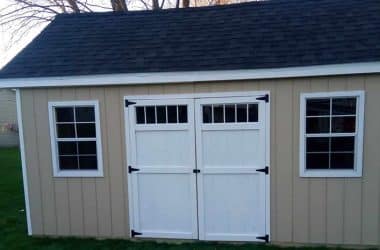
Notched skids can be a valuable asset to the shed industry, which might be why they remain in high demand.
Here are some ways the skids, also called runners, can benefit shed builders, from the construction process to the finished product.
Leroy Hershberger, owner of Lakeshore Mini Barns in Shawano, Wisconsin, who builds and sells portable outdoor structures, switched to notched skids a few years back.
“If it’s a portable building, especially a big building, they create a lot of strength to your floor. In transportation, that’s where you can tell a big difference. We used 4 by 4s and switched to notched 4 by 6 skids,” he says.
“With the angled ends, when you go to slide that building that’s sitting on the ground, it pulls a lot easier, and the skid won’t pull into the ground.”
“Most builders utilize notched runners for simplicity. They’re just fast and efficient,” says Erica Goodnight, CEO of Union Grove Lumber Inc. in Harmony, North Carolina, a stocking wholesale lumber supplier that warehouses their material directly from the mill.
“Every manufacturer of notched runners utilizes a different machine.”
Their notched runners are doubled-notched with notches every 12 inches on center or 16 inches on center.
“Others might use a DADO saw, and this may be a faster tool, but not as precise,” she adds. “Obviously the more that are produced the better, but our robot can only go so fast. You cannot speed it up and you cannot slow it down.”
Goodnight says it’s important for shed builders to utilize notched runners to set up a floor system.
“If the floor joists are not aligned perfectly square, then the building is off. If the notched runners are not precise, builders have to go in and fix it and make it plumb,” she explains.
“Without notched runners, the builders definitely have to measure, time and time again.”
The pre-notched skids also speed up building time because they don’t have to pre-mark everything, adds Hershberger.
“The reason we switched was to add more strength to the building and to our floor when moving the building, but we got a nice surprise when building time was saved having notched skids,” he says.
There are three systems that shed builders use. They can set up a floor system with 4 by 4s that are not notched or 4 by 6s that are not notched or 4 by 6s that are notched.
With notched runners, builders can expect a price increase compared to blank 4 by 4s or 4 by 6s.
“Notched runners cost more because of the labor involved at the manufacturer’s level, but builders should consider the savings: they save labor because they can just pop in the floor joists without having to measure and it cuts down on supplies because less nails are used in notched runners than in toe-nailing into blank 4 bys,” says Goodnight.
“Without a notch to hold the floor, it’s just a little less secure and they have to measure twice and nail once or they can end up with a shed that’s like a crooked house. With notched runners, you can eliminate a lot of nails, and you don’t have to measure time and time again.”
The notched runners not only have the notch in them, but they taper the very end as well into a 45-degree angle.
“We cut them kind of like a sled where it curls up on both ends. The portability of barns and sheds is very important. Builders and dealers are moving them around constantly to dealer lots and homes and when they repo them,” she says.
“The buildings have a minimum of two moves in a lifetime, but sometimes they are moved 10 times before they even make it to their destination. Having the 45-degree angle on the ends of the runners allows it to just glide along more smoothly and there is less wear and tear.”




